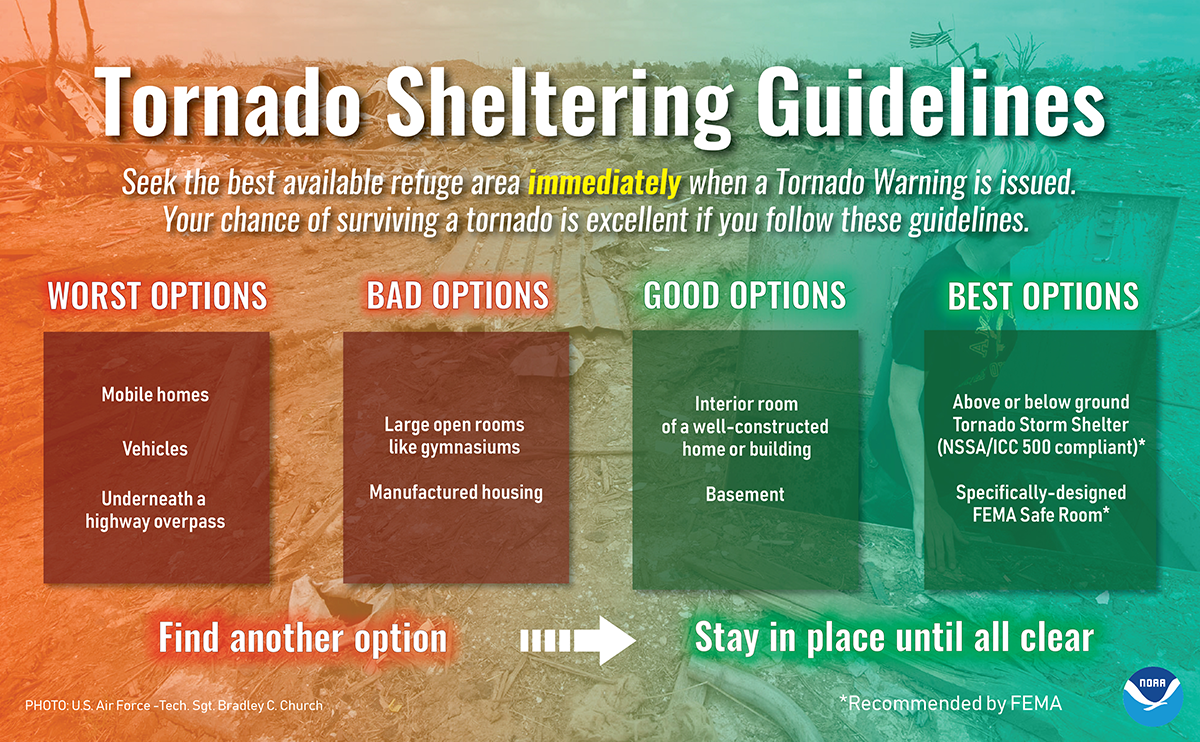Campground Weather-Ready Checklist
SUMMARY
Plan
Practice
Monitor
Act
Worksheet
The first four elements provide an effective, comprehensive approach to severe weather preparedness. Each element is a part of the whole. If any piece is missing, you don't have a complete pie, and you won't have the same result. The final element provides tool to help you develop your plan.
PLAN
Identify and clearly mark storm shelters
- Lightning Shelters: https://www.weather.gov/jetstream/lightning_safety
- Severe Thunderstorms/Tornadoes Shelters:

Know Where to Get Weather Information
Have multiple ways of receiving weather forecasts and warnings which can include any of the following:
- Operational NOAA Weather Radio in a staffed location
- Subscribe to have weather alerts delivered to your cell phone: www.weather.gov/subscribe
- Smartphone applications
- Enable Wireless Emergency Alerts (WEA) on your cell phone: https://www.weather.gov/wrn/wea
- Bookmarked list of weather Internet sites which should include www.weather.gov/rnk (have available multiple ways to access the internet in the event of power loss)
- Battery powered AM/FM radio
- Register for alerts through your local government
Communication Abilities to Disseminate Weather Warnings
Demonstrate multiple ways of communicating / disseminating important weather information through your facility which can include any of the following:
- Public Announcement (PA)
- Text Alerting System
- Sirens
- Phone calls/Phone tree
- Email lists
- Electronic signs
- Setup a weather hotline for campers to call in to reach a recorded message highlighting daily threats
return to top
PRACTICE
- Practice your plan at least once a year
- Participate in annual statewide tornado drills: https://www.weather.gov/safety/events_calendar
- Practice moving to your identified shelters
- Consider taking an NWS SKYWRARN Spotter Training class online: www.weather.gov/rnk/skywarn
- Develop outdoor signs raising awareness to daily hazardous weather threats
- Provide campers with weather preparedness handouts for thunderstorms, flash flooding, heat and wildfires
- Ensure all new staff is trained in hazardous weather threats and plans
- Review all weather threat plans, and update as needed
- Update your list & bookmarks of weather web sites
- Update all contact lists, phone number and email lists
- Reach out to your city or county emergency manager to maintain awareness of your organizational response, preparation and communication plan

return to top
MONITOR
Always designate a weather watcher who is responsible for monitoring weather conditions and have multiple ways to receive weather alerts. Check the forecast at least once a day.
DO NOT rely on sirens!
Resources
- www.weather.gov/rnk and https://www.weather.gov/rnk/emer
- NOAA Weather Radio
- Local TV and Radio stations
- Social Media: @NWSBlacksburg of fb.com/NWSBlacksburg
- Smartphone weather apps
- Subscribe to have weather alerts delivered: www.weather.gov/subscribe
Self-briefing sources (consider bookmarking these sites):
Resources for 3-7 days in advance of the event:
- NWS hazardous weather outlook: https://www.weather.gov/erh/ghwo?wfo=rnk
- Severe Weather: https://www.spc.noaa.gov/products/exper/day4-8/
- Flash Flooding/Rainfall: https://www.wpc.ncep.noaa.gov/#page=qpf
- Heat Index: https://www.wpc.ncep.noaa.gov/heat_index.shtml
Resources for 1-3 days in advance of the event:
- NWS website: www.weather.gov/rnk
- Hourly Weather Forecast: https://forecast.weather.gov/gridpoint.php?site=rnk&TypeDefault=graphical
- Severe Weather: : https://www.spc.noaa.gov/products/outlook/
- Flash Flooding: https://www.wpc.ncep.noaa.gov/#page=ero
- Heat Index: https://go.usa.gov/xtGTA
Resources for the Winter Forecast: www.weather.gov/rnk/winter
Resources for Situational Awareness (day of the event)
- https://go.usa.gov/xtGTF
- https://weather.im/iembot/ (select "rnkchat Blacksburg")
return to top
ACT
Act IMMEDIATELY when a severe thunderstorm or tornado warning is issued, as you may only have a few minutes of lead time
- GET IN: Move to your pre-designated storm shelters
- GET DOWN: To the lowest floor
- COVER UP: Falling and flying debris causes the most injuries and fatalities during storms
Establish sheltering/response criteria
- Based on watches, warnings, reports, other?
- Consider how much time you need for people to reach shelter
How will action be initiated
- Means of communication -- How will campers be notified?
- Backup plan
Appropriate Sheltering
- Interior of a building
- Rooms without windows
- Roof tied to walls: walls tied to foundation
- Protection from "missiles" (flying objects)
Enough Space?
- Consider number of visitors
- Enough time to reach shelter
- How will you communicate an "All-Clear" message?
Questions? Call the National Weather Service in Blacksburg at 540-553-8900 or email: rnk.skywarn@noaa.gov
return to top
EFFECTIVE SEVERE WEATHER PLAN WORKSHEET
1. Who is the designated weather watcher? _____________________________________
2. Identify thresholds and actions:
| Threat |
Threshold(s) |
Actions |
| Flooding |
|
|
| Heat |
|
|
| Lightning |
|
|
| Severe thunderstorms/Tornadoes |
|
|
| Winter Weather |
|
|
3. Communication: How will the threat be communicated and with whom?
List methods of communicating with staff and visitors (should be at least three methods)
1._______________________________________________________________________________________
2._______________________________________________________________________________________
3._______________________________________________________________________________________
4. Sheltering: Identify shelter areas:
| Move from this area |
To this area |
| |
|
| |
|
5. Training: Train all staff and their roles:
a. Training Completed:_____________________________
6. Sheltering Drills:
a. Drill Completed:_____________________________
b. Time to shelter:_____________________________
7. Leaving the shelter area:
a. Who decides?:_____________________________
b. How is this communicated?:_____________________________
return to top
Downloadable .pdfs
Click the link to download a .pdf version of this page - Hazardous Weather Plan for Camping_Hiking.pdf
Click the link to download a .pdf version of the Effective Severe Weather Plan Worksheet - severeweatherworksheet.pdf

RETURN TO THE PREPAREDNESS MENU

